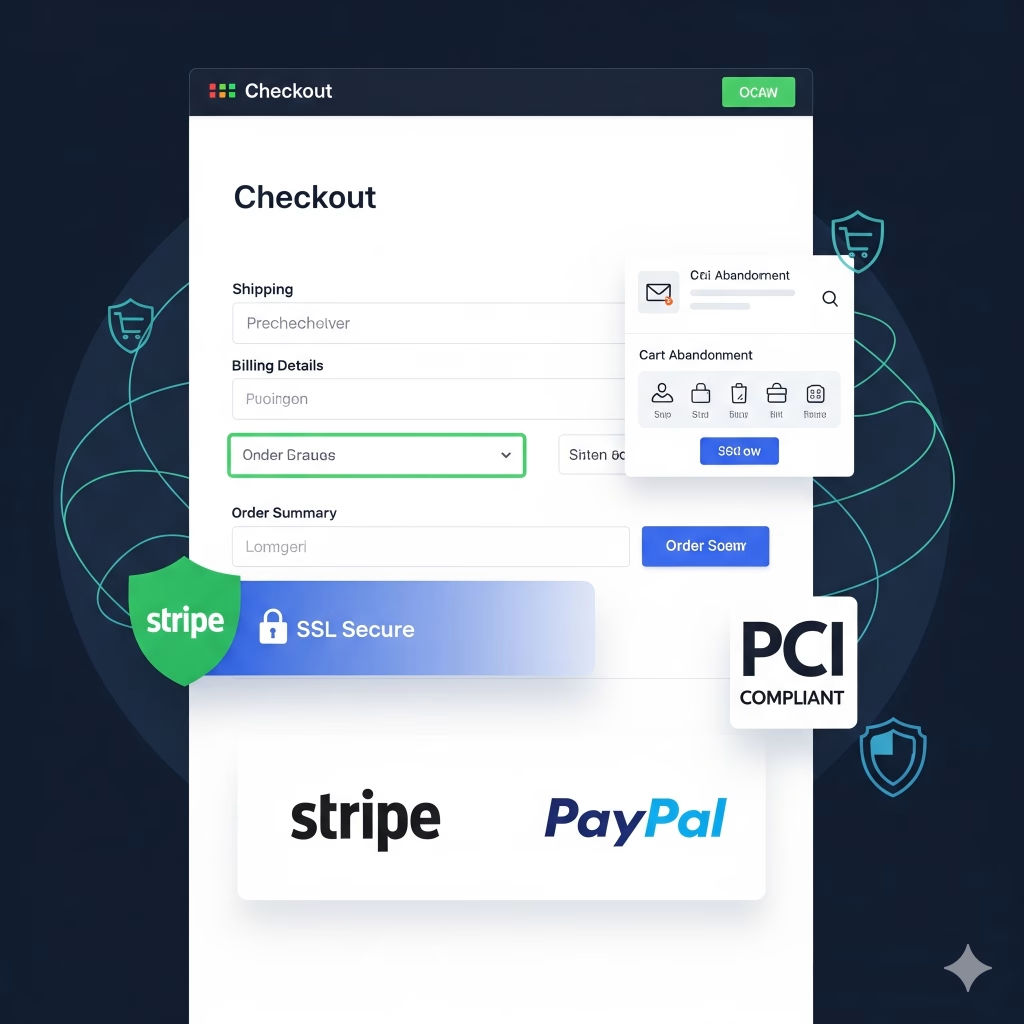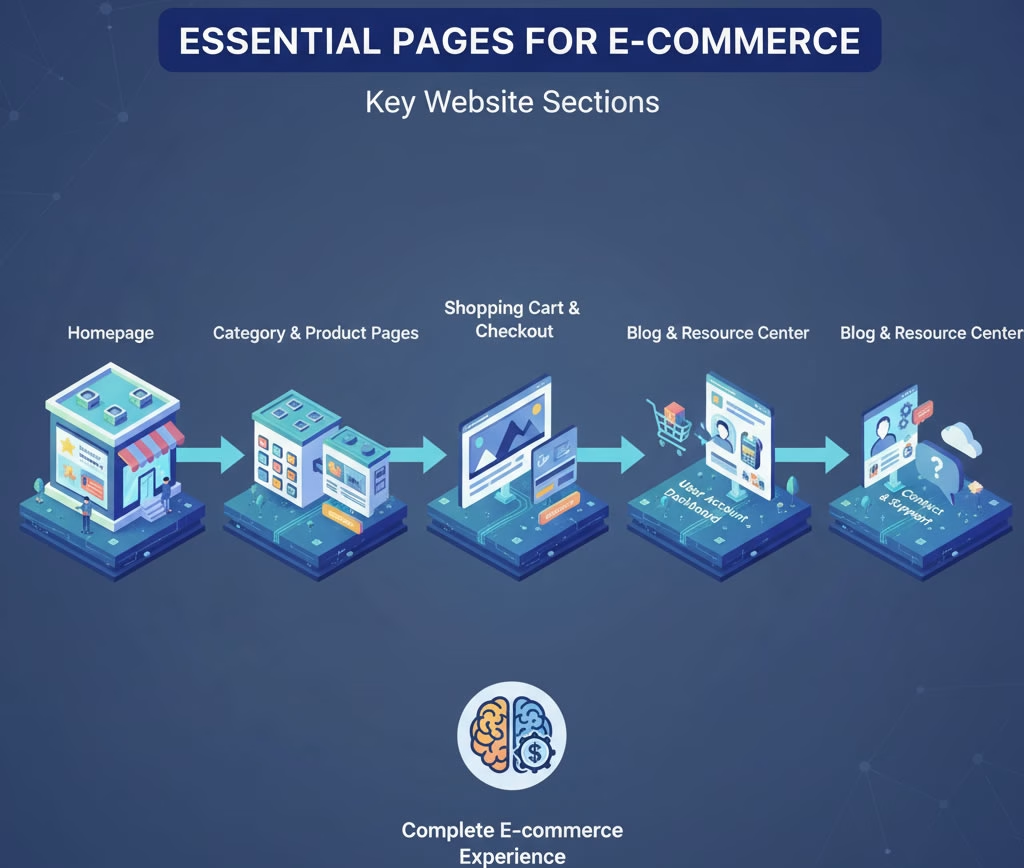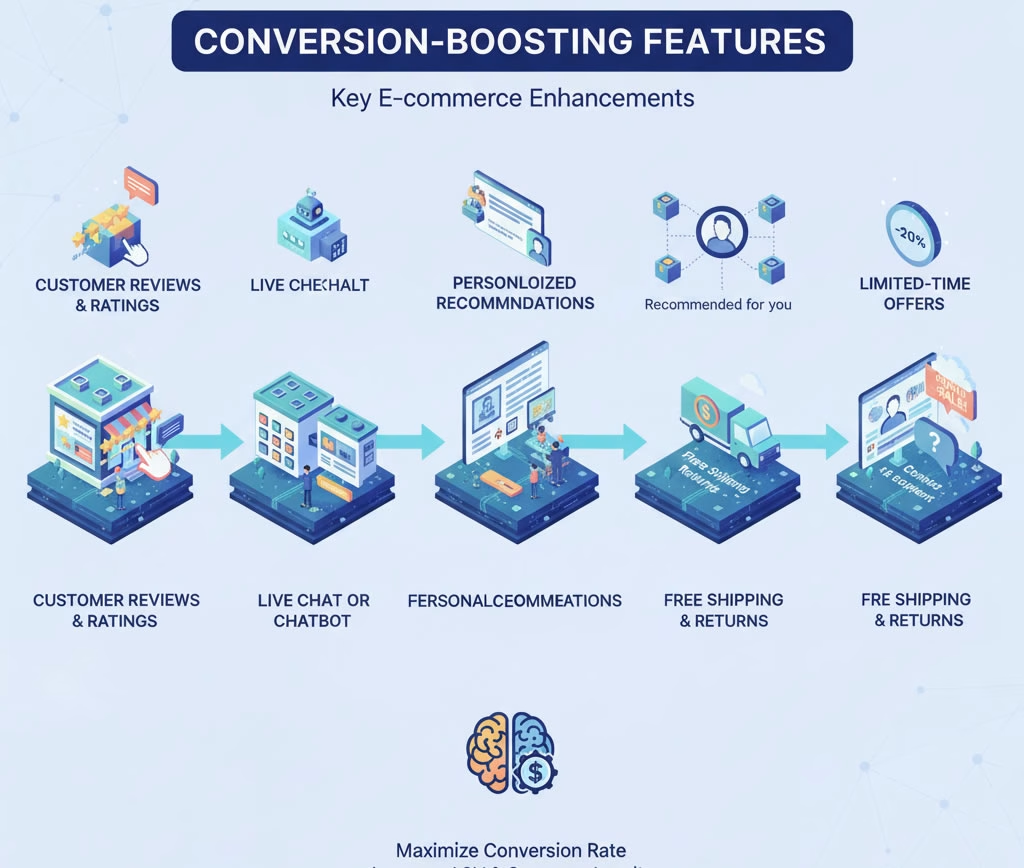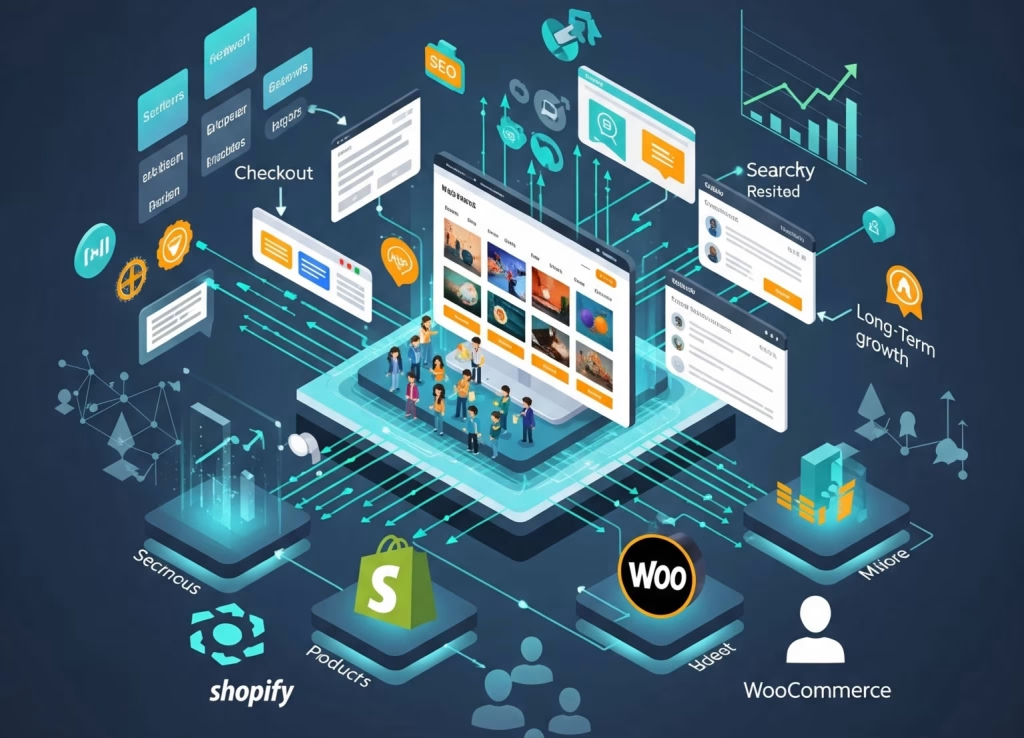
Key Elements of E-Commerce Web Design
- User Experience (UX)
- Clear navigation
- Mobile-first design
- Fast loading times
- Accessible design for all users
- Visual Design
- Modern layout
- High-quality product images
- Consistent branding
- Effective use of white space
- Functionality
- Secure checkout process
- Multiple payment gateways
- Advanced product filtering
- Wishlist and saved items
- SEO & Marketing
- Optimized product pages
- Structured metadata
- Integrated blog
- Social media and email integrations
- Scalability
- Flexible CMS
- Multi-language support
- Inventory management
- Third-party integrations

Essential Pages for an E-Commerce Website
- Homepage with featured products
- Category and product pages
- Shopping cart and checkout
- User account dashboard
- Blog and resource center
- Contact and support page

Conversion-Boosting Features
- Customer reviews and ratings
- Live chat or chatbot support
- Personalized product recommendations
- Free shipping and return policies
- Limited-time offers and discounts

E-Commerce Platforms:
| Feature | Shopify | WooCommerce | Magento |
|---|---|---|---|
| Ease of Use | Very beginner friendly | Moderate | Complex |
| Customization | App marketplace, templates | Highly customizable with plugins | Fully customizable |
| Cost | Monthly subscription + apps | Free plugin + hosting fees | High setup and maintenance costs |
| Performance | Optimized hosting included | Dependent on hosting provider | Requires strong server resources |
| Best For | Startups and SMEs | Small to mid-size stores | Large enterprises |

We’re an E-Commerce Web Design Company
At Wemaxa we go far beyond just building a storefront and instead engineer complete digital commerce ecosystems designed to generate long term growth. An effective e commerce website needs far more than a template theme and a product upload it requires carefully structured architecture, targeted SEO implementation, thoughtful conversion design, and technology choices that match the scale of your ambition. We design product catalogs that are search engine friendly while remaining simple to navigate for end users, ensuring every SKU is tagged with descriptive metadata, optimized titles, schema markup, and canonical structure to avoid duplication issues. Instead of relying on default platform settings, we optimize category hierarchies, create parent-child relationships for complex products, and implement advanced filtering that works equally well on desktop and mobile. Our approach focuses on marrying UX design with marketing intent: category pages that act as long-form landing pages to capture organic traffic, transactional product pages that close the sale, and supporting content such as blogs, guides, or case studies that expand topical authority. The combination of structured data, server side rendering, mobile performance optimization, and intelligent internal linking from categories, blog posts, and service pages ensures that search engines treat the store as a relevant, authoritative destination. Our experience spans Shopify, WooCommerce, custom WordPress builds, and headless architectures where React or Vue front ends connect to back end commerce APIs. Clients seeking rapid deployment may prefer Shopify with its ecosystem of apps and SaaS infrastructure, while businesses looking for full ownership and extensibility often opt for WooCommerce where WordPress acts as both CMS and commerce platform. You can explore the reasoning behind this on our detailed guide Is WordPress good for e-commerce? which explains why so many retailers trust WooCommerce for flexibility and control. For design specifics and implementation packages tailored to your industry, review our Web Design services overview which outlines the creative and technical layers we bring to every e commerce project.

Once product architecture and design foundations are in place, the critical factor that determines whether browsers become buyers is checkout trust and payment flexibility. Our e commerce builds include integration with the most widely trusted gateways including Stripe, PayPal, and regional providers such as Klarna, Sofort, Giropay, or Afterpay depending on your audience. Beyond enabling multiple payment methods, we design checkout flows that reduce friction with techniques such as one-page checkout, guest checkout options, and tokenized saved payment methods for returning customers. PCI compliance, SSL encryption, strong content security policy rules, and fraud protection layers are built into every deployment. We also build trust through clear shipping policies, transparent returns, customer service visibility, and verified third party seals when appropriate. On the revenue recovery side, we implement cart abandonment systems that track at SKU level, allowing personalized follow ups via email or SMS reminding users of products left behind. Our systems integrate abandoned cart workflows into Shopify Flow, WooCommerce plugins, or standalone CRMs depending on business setup. We also configure upsell and cross sell opportunities in the cart and checkout flow so buyers are naturally introduced to complementary products. Combined with post-purchase email sequences that encourage reviews, repeat purchases, and loyalty program engagement, these workflows extend the revenue per customer beyond the initial transaction. Our Pricing & Plans page details the different levels of support we offer from basic online shop setup to fully integrated enterprise-grade commerce systems. We also encourage you to review our FAQ where common questions about online shop builds, platform recommendations, and support terms are addressed in depth.

Operations and automation form the backbone of sustainable e commerce growth. Our builds always include robust inventory management with real time synchronization across your channels, ensuring you never oversell or disappoint customers. When connected with marketplaces like Amazon or eBay, or with physical retail inventory, our systems provide two-way stock synchronization.
We integrate shipping logic that accounts for package dimensions, destination, and carrier contracts, giving you automated rate calculations and efficient label printing. For stores handling large SKU counts or multiple warehouses, we integrate ERP systems and inventory forecasting models that use sales history to anticipate restocking needs. Logistics automation reduces manual effort while maintaining full visibility of order flow from checkout to delivery. Customers receive real-time status updates, and merchants gain dashboards showing bottlenecks, shipping cost analysis, and carrier performance.
We design email flows covering the entire customer journey from order confirmation to shipping notification and delivery confirmation, with post purchase review prompts that feed back into your SEO through structured data reviews on product pages. To further strengthen customer engagement, we integrate loyalty programs, referral systems, and subscription billing models that provide predictable recurring revenue. Our team also implements advanced analytics beyond just Google Analytics capturing funnel steps, tracking micro conversions, and feeding data into attribution dashboards that reveal which marketing campaigns are truly profitable. When paired with personalization and A/B testing, you gain not just operational efficiency but also a constant improvement loop where customer behavior informs product positioning and marketing spend. To see how these technical workflows tie into Wemaxa’s holistic approach, view our Services section where e commerce automation is explained as part of the wider service offering.
Search engine optimization in e commerce must go beyond keyword stuffing and requires a systematic blend of technical SEO, on page optimization, content marketing, and authority building. We create category pages that rank for commercial intent phrases, long form landing pages that capture mid funnel researchers, and concise product detail pages that target transactional queries. Every product page is enriched with structured data for product, price, availability, and reviews, enabling rich snippets that increase click through rates. Breadcrumb navigation, XML sitemaps, robots directives, and canonical controls are managed carefully to ensure Google and other search engines index only the correct versions of your content. On top of this technical layer, we build topical authority through blogs, buying guides, and evergreen content that link internally to high value products and categories. These content assets also provide anchor points for backlink acquisition from authoritative external sites, increasing domain authority. For global or multilingual stores, we implement hreflang markup and regional targeting so you can serve localized content while preserving consolidated SEO equity. We also optimise for image search by tagging all images with descriptive alt text and filenames, as well as generating WebP variants to improve speed and indexing. Search engine visibility is not static: algorithm updates shift emphasis, so we include monitoring systems that track keyword movements, traffic by landing page, and crawl anomalies. Our SEO strategy is proactive rather than reactive, helping you capture organic growth while competitors scramble to adjust. For technical audits, remediation roadmaps, or long-term SEO retainers attached to your store, explore our Professional Package and related plans which explain how SEO is baked into our builds from day one.

The future of e commerce lies in personalization, AI driven automation, and modular architectures that scale with your business. Wemaxa integrates recommender engines that personalize product listings in real time based on customer signals such as viewed products, abandoned carts, purchase history, and onsite search behavior. For large catalogs, we deploy machine learning models that dynamically rank results to emphasize high margin or trending items. AI is also applied to backend operations forecasting demand, optimizing pricing strategies, predicting customer lifetime value, and reducing returns by identifying risk factors before they occur. Visual search and AI powered tagging improve product discovery while reducing manual tagging workload for merchants. We also build headless commerce setups where Shopify, WooCommerce, or custom APIs serve as the transactional engine while a React, Next.js, or Vue front end delivers lightning fast user experiences. These architectures allow for modular scaling, faster iteration, and seamless integration with third party services from CRMs to marketing automation platforms. Privacy and compliance are integrated at every stage: consent management, GDPR compliant data storage, and transparent data policies ensure personalization is effective without regulatory risk. Our enterprise builds combine AI, automation, multilingual support, subscription models, ERP integration, and advanced analytics into a unified digital commerce ecosystem. If your goal is to attract, convert, and retain customers with a modern, scalable online store, visit our Services and FAQ pages where you can see how we approach complex e commerce implementations and how we deliver solutions tailored to your growth path.


